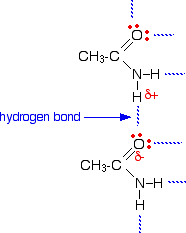| INTRODUCING AMIDES . What are amides? Amides are derived from carboxylic acids. A carboxylic acid contains the -COOH group, and in an amide the -OH part of that group is replaced by an -NH2 group. So . . . amides contain the -CONH2 group. Some simple amides The most commonly discussed amide is ethanamide, CH3CONH2 (old name: acetamide). 
If the chain was branched, the carbon in the -CONH2 group counts as the number 1 carbon atom. For example:  Physical properties Melting points Methanamide is a liquid at room temperature (melting point: 3°C), but the other amides are solid. For example, ethanamide forms colourless deliquescent crystals with a melting point of 82°C. A deliquescent substance is one which picks up water from the atmosphere and dissolves in it. Ethanamide crystals nearly always look wet. | |||||||
The melting points of the amides are high for the size of the molecules because they can form hydrogen bonds. The hydrogen atoms in the -NH2 group are sufficiently positive to form a hydrogen bond with a lone pair on the oxygen atom of another molecule. These hydrogen bonds need a reasonable amount of energy to break, and so the melting points of the amides are quite high. | |||||||
| | |||||||
| Solubility in water The small amides are soluble in water because they have the ability to hydrogen bond with the water molecules. It needs energy to break the hydrogen bonds between amide molecules and between water molecules before they can mix - but enough energy is released again when the new hydrogen bonds are set up to allow this to happen. | |||||||
Kamis, 31 Mei 2012
introducing amides
Langganan:
Posting Komentar (Atom)
why The melting points of the amides are high for the size of the molecules ?? why not lower??
BalasHapuswhy ethanamide forms colourless deliquescent crystals with a melting point of 82°C. ? why not lower than it?
BalasHapus